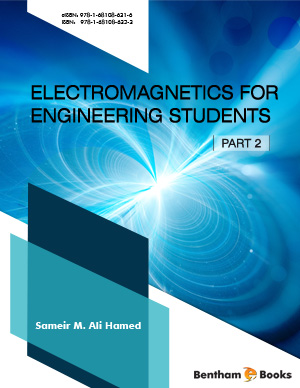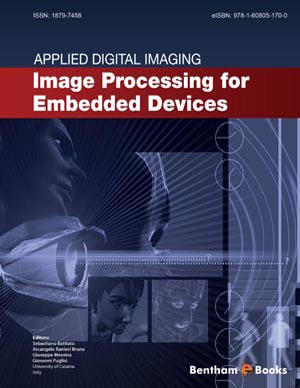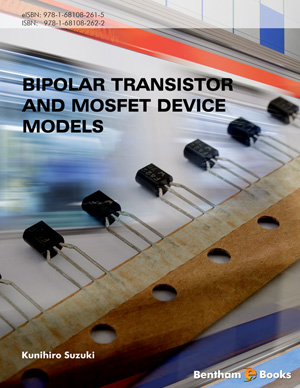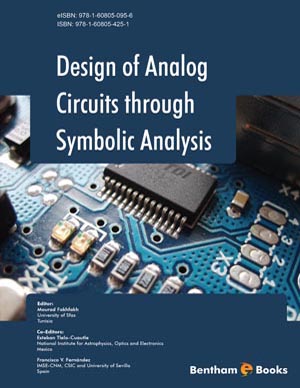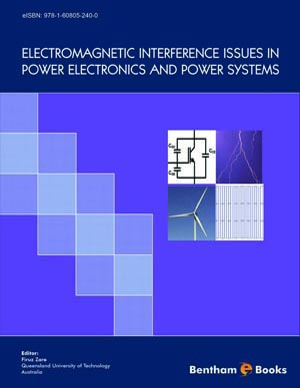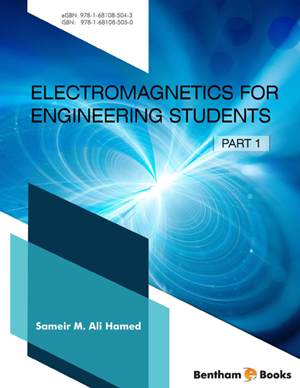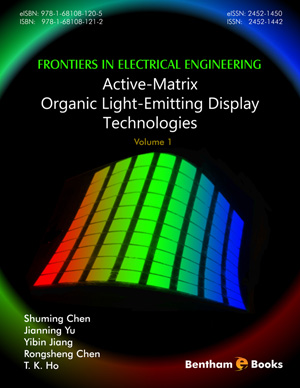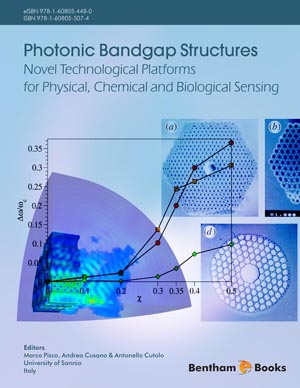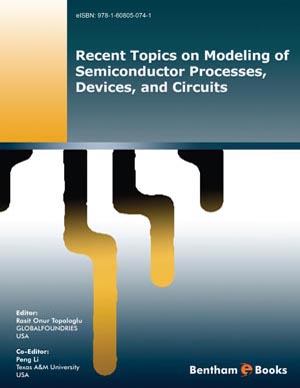Propagation of Uniform Plane Waves
Page: 1-62 (62)
Author: Sameir M. Ali Hamed
DOI: 10.2174/9781681085043117010010
PDF Price: $15
Abstract
Maxwell’s equations are applied in this chapter to investigate the behavior of electromagnetic plane waves propagation in unbounded homogeneous media. The behavior of electromagnetic waves propagating in a homogeneous medium is determined by its electrical properties (permittivity, permeability, and conductivity) and the operating frequency. General formulas for electromagnetic field components and basic characteristics such as loss tangent, attenuation constant, phase constant, propagation constant, intrinsic impedance, phase velocity, wavelength, and skin depth are derived for an arbitrary medium assuming plane wave propagation. These general formulas are used to study the behavior of uniform plane waves propagating in lossless dielectrics, lossy dielectrics, and good conducting media. Moreover, the concepts of wave polarization and group velocity are also discussed in this chapter. The topics of the chapter are supported by numerous illustrative examples and figures in addition to solved problems and homework problems at the end of the chapter.
Reflection, Transmission, and Negative Refraction
Page: 63-124 (62)
Author: Sameir M. Ali Hamed
DOI: 10.2174/9781681085043117010011
PDF Price: $15
Abstract
Reflection and transmission occur when electromagnetic waves incident on an interface between two different media. At the interface, a part of the incident wave reflects back and the other part penetrates into the other medium. Many applications in communication systems such as transmission of electromagnetic energy through waveguides, reflection of radio waves from the ionosphere, directing the electromagnetic energy by reflector antennas, and transmission through optical fiber cables are based on the reflection and transmission of electromagnetic plane waves. This chapter deals with reflection and transmission of electromagnetic waves for different polarizations of the incident wave. The negative refraction phenomenon is also discussed in this chapter. The topics of the chapter are supported by numerous illustrative examples and figures in addition to solved problems and homework problems at the end of the chapter.
Rectangular Waveguides
Page: 125-194 (70)
Author: Sameir M. Ali Hamed
DOI: 10.2174/9781681085043117010012
PDF Price: $15
Abstract
The transmission media may be unbounded as free space or bounded. The behavior of electromagnetic waves in unbounded media has been dealt with in Chapter 8. The bounded media are structures that are constructed from conducting or/and dielectric materials such as transmission lines, waveguides, and optical fiber cables. Waveguides are constructed from metallic tubes filled with a dielectric material or dielectric slabs with a rectangular, circular or elliptical cross section. This chapter deals with a metallic waveguide of rectangular cross section. The general equations that govern the electromagnetic waves propagation in the waveguide are derived starting from Maxwell's equations. These general equations are used to analyze the behavior of electromagnetic waves and power flow in the metallic waveguide of a rectangular cross section. The topics of the chapter are analyzed in details and supported by numerous illustrative examples and figures in addition to solved problems. Homework problems are included at the end of the chapter.
Circular Waveguides
Page: 195-230 (36)
Author: Sameir M. Ali Hamed
DOI: 10.2174/9781681085043117010013
PDF Price: $15
Abstract
This chapter is a continuation of Chapter 10 and devoted to discuss the waveguides of a circular cross-section. The general formulations for the metallic waveguides that are presented in Chapter 10, will be applied in this chapter to analyze the behavior of electromagnetic waves and power flow in the metallic waveguide of circular cross-section. The topics of the chapter are analyzed in details and supported by numerous illustrative examples and figures in addition to solved problems. Homework problems are included at the end of the chapter.
Resonant Cavities
Page: 231-264 (34)
Author: Sameir M. Ali Hamed
DOI: 10.2174/9781681085043117010014
PDF Price: $15
Abstract
The resonant cavities are structures used to store the electromagnetic energy at high frequencies. Cavities may be rectangular, cylindrical, or spherical in geometry. This chapter is devoted to discuss the rectangular and cylindrical cavities and their characteristics. The electromagnetic fields in the rectangular and cylindrical cavities are obtained by considering the cavities as shorted waveguides at their ends with two additional walls. The most important parameters that characterize the cavity are its resonant frequency and quality factor. The quality factor is a parameter that gives a measure of the ratio of the stored energy in the cavity to the dissipated power at a certain frequency. A detailed derivation for the electromagnetic fields, resonant frequency, and the quality factor are presented for both the rectangular and cylindrical cavities. The topics of the chapter are supported by a number of illustrative examples, figures, and solved problems. Homework problems are included at the end of the chapter.
Transmission Lines
Page: 265-353 (89)
Author: Sameir M. Ali Hamed
DOI: 10.2174/9781681085043117010015
PDF Price: $15
Abstract
Transmission media in the communications system may be unbounded such as free space or bounded. The bounded transmission media include waveguides, optical fiber cables, and transmission lines. Transmission lines are made from two or more conductors separated by a dielectric material and they can transmit signals in a wide range of frequencies including DC signals. However, beyond certain frequencies, the transmission lines become inefficient in the transmission of electromagnetic power. This chapter focuses on the transmission lines and their characteristics in the frequency domain. The per unit line parameters and characteristics for some widely used transmission lines, such as coaxial cables, parallel wires lines, parallel plates lines, and micro-strip lines, are presented. The detailed discussion on reflection coefficient and voltage standing wave for terminated transmission lines is also presented. Applications of Smith chart in transmission lines calculations is covered at the end of the chapter. The topics of the chapter are analyzed in details and supported by illustrative examples and figures in addition to solved problems. Homework problems are included at the end of the chapter.
Principles of Antennas
Page: 354-445 (92)
Author: Sameir M. Ali Hamed
DOI: 10.2174/9781681085043117010016
PDF Price: $15
Abstract
The antenna plays an essential role in sending and receiving information in the wireless communication systems. In addition to communication systems antennas are used in astronomy, geophysical probing, medicine and biological tissues, and radio frequency identification systems. Based on their geometrical structure, antennas may be classified into wire antennas; aperture type antennas; microstrip antennas; array antennas; reflector antennas; lens antennas. This chapter introduces the basic principles of antennas beside some topics related to antennas such as reciprocity theorem, Friis transmission formula, and general formulations for far-field approximations. As examples of the antenna analysis, the basic antenna parameters, and radiation characteristics are obtained for wire antennas and simple array antennas. The topics of the chapter are analyzed in details and supported by illustrative examples and figures in addition to solved problems. Homework problems are included at the end of the chapter.
Appendix A: Bessel Functions
Page: 446-449 (4)
Author: Sameir M. Ali Hamed
DOI: 10.2174/9781681086316118010010
Appendix B: Associated Legendre Functions
Page: 450-452 (3)
Author: Sameir M. Ali Hamed
DOI: 10.2174/9781681086316118010011
Appendix C: Useful Integrals and Mathematical Formulas
Page: 453-456 (4)
Author: Sameir M. Ali Hamed
DOI: 10.2174/9781681086316118010012
Appendix D: Frequency Bands
Page: 457-458 (2)
Author: Sameir M. Ali Hamed
DOI: 10.2174/9781681086316118010013
Appendix E: Physical Constants
Page: 459-459 (1)
Author: Sameir M. Ali Hamed
DOI: 10.2174/9781681086316118010014
Introduction
Electromagmetics for Engineering Students is a textbook in two parts, Part I and II, that cover all topics of electromagnetics needed for undergraduate students from vector analysis to antenna principles. In both parts of the book, the topics are presented in sufficient details such that the students will follow the analytical development easily. Each chapter is supported by many illustrative examples, solved problems, and the end of chapter problems to explain the principles of the topics and enhance the knowledge of the student. There are a total of 681 problems in the both parts of the book as follows: 162 illustrative examples, 88 solved problems, and 431 end of chapter problems. This part is a continuation of Part I and focuses on the application of Maxwell's equations and the concepts that are covered in Part I to analyze the characteristics of wave propagation in half-space and bounded media including metamaterials. Moreover, a chapter has been devoted to the topic of antennas to provide readers with the fundamental concepts related to antenna engineering. The key features of this part: • In addition to the coverage of classical topics in electromagnetic normally covered in the similar available texts, this part of the book adds some advanced concepts and topics such as: • Application of multi-pole expansion for vector potentials. • More detailed analysis on the topic of waveguides including circular waveguides. • Refraction through metamaterials and the concept of negative refractive index. • Detailed and easy-to follow presentation of mathematical analyses and problems. • An appendix of mathematical formulae and functions.


